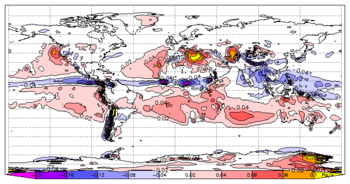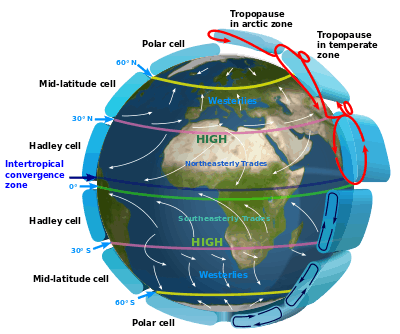Hadley cell

The Hadley cell, named after George Hadley, is a tropical atmospheric circulation that features air rising near the equator, flowing poleward at 10–15 kilometers above the surface, descending in the subtropics, and then flowing equatorward near the surface. This circulation creates the trade winds, tropical rain-belts and hurricanes, subtropical deserts and the jet streams.
There is one primary circulation cell known as a Hadley cell and two secondary circulation cells at higher latitudes, known as the Ferrel cell, and Polar cell. It can consist from 30 to 40 degrees north and south and is mainly responsible for the weather in the equatorial regions of the world.
Mechanism
The major driving force of atmospheric circulation is solar heating, which is greatest near the equator and lesser at the poles. The atmospheric circulation transports energy polewards, thus reducing the resulting equator-to-pole temperature gradient. The mechanisms by which this is accomplished differs in tropical and extratropical latitudes.
Hadley cells exist on either side of the equator. Each cell encircles the globe and acts to transport energy from the equator to 30th latitude. This is the result of the buoyancy of warm air rising from the equator to the tropopause; its movement as it is pushed poleward by air rising from below; its cooling as it moves poleward at high altitude; its sinking near subtropics (30th parallels); and finally its equatorward return near the surface, completing the loop. In higher latitudes, the energy transport is also accomplished by cyclones and anticyclones that cause relatively warm air to move polewards and cold air to move equatorwards. The large scale tropical overturning cell is referred to as the Hadley cell. Why it extends only to 30 degrees latitude and what determines its strength are questions addressed by dynamical meteorology.
Near the tropopause, as the air moves polewards in the Hadley cell, it is turned eastward by the Coriolis effect, creating the subtropical jet streams that flow from west to east. Analogously, near the surface, the equatorward return flow is turned to the west by the Coriolis effect. These resulting surface winds, with both an equatorward and a westward component, are referred to as the trade winds.
The Hadley system provides an example of a thermally direct circulation. The thermodynamic efficiency of the Hadley system, considered as a heat engine, has been relatively constant over the 1979~2010 period, averaging 2.6%. Over the same interval, the power generated by the Hadley regime has risen at an average rate of about 0.54 TW per yr; this reflects an increase in energy input to the system consistent with the observed trend in the tropical sea surface temperatures.[1]
History of discovery

In the early 18th century, George Hadley, an English lawyer and amateur meteorologist, was dissatisfied with the theory that the astronomer Edmond Halley had proposed for explaining the trade winds. What was no doubt correct in Halley's theory was that solar heating creates upward motion of equatorial air, and air mass from neighboring latitudes must flow in to replace the risen air mass. But for the westward component of the trade winds Halley had proposed that in moving across the sky the Sun heats the air mass differently over the course of the day. Hadley was not satisfied with that part of Halley's theory and rightly so. Hadley was the first to recognize that Earth's rotation plays a role in the direction taken by an air mass as it moves relative to the Earth. Hadley's theory, published in 1735, remained unknown, but it was rediscovered independently several times. Among the re-discoverers was John Dalton, who later learned of Hadley's priority. Over time the mechanism proposed by Hadley became accepted, and over time his name was increasingly attached to it. By the end of the 19th century it was shown that Hadley's theory was deficient in several respects. One of the first who accounted for the dynamics correctly was William Ferrel. It took many decades for the correct theory to become accepted, and even today Hadley's theory can still be encountered occasionally, particularly in popular books and websites.[2] Hadley's theory was the generally accepted theory long enough to make his name become universally attached to the circulation pattern in the tropical atmosphere. In 1980 Isaac Held and Arthur Hou developed the Held-Hou Model to describe the Hadley circulation.


Major impacts on precipitation by latitude
The region in which the equatorward moving air masses converge and rise, is known as the intertropical convergence zone, or ITCZ. Within that zone develops a band of thunderstorms that produce high-precipitation.
Having lost most of its water vapor to condensation and precipitation in the upward branch of the Hadley cell circulation, the descending air is dry. As the air descends, low relative humidities are produced as the air is warmed adiabatically by compression from the overlying air, producing a region of higher pressure. The subtropics are relatively free of the convection, or thunderstorms, that are common in the equatorial belt. Many of the world's deserts are located in these subtropical latitudes.
Hadley cell expansion
There is some evidence that the expansion of the Hadley cells is related to climate change.[3] The majority of Earth's arid regions are located in the areas beneath the descending part of the Hadley circulation at around 30 degrees latitude.[4] Those models show that the Hadley cell will expand with increased global mean temperature (perhaps by 2 degrees latitude over the 21st century [5]). This might lead to large changes in precipitation in the latitudes at the edge of the cells.[4] Scientists fear that global warming might bring changes to the ecosystems in the deep tropics and that the deserts will become drier and expand.[5] As the areas around 30 degrees latitude become drier, those inhabiting that region will see less rainfall than traditionally expected, which could cause difficulty with food supplies and livability.[6] There is strong evidence of paleoclimate climate change in central Africa's rain forest in c. 850 B.C.[7] Palynological (fossil pollen) evidence shows a drastic change in rain forest biome to that of open savannah as a consequence of wide-scale drying not connected necessarily to intermittent drought but perhaps to gradual warming. The hypothesis, that a decline in solar activity reduces the latitudinal extent of the Hadley Circulation and decreases mid-latitudinal monsoon intensity, is matched by data, showing increased dryness in central west Africa and increase in precipitation in temperate zones north. Meanwhile, mid-latitudinal storm tracks in the temperate zones increased and moved equatorward.[8]
See also
References
- ↑ Junling Huang; Michael B. McElroy (2014). "Contributions of the Hadley and Ferrel Circulations to the Energetics of the Atmosphere over the Past 32 Years". Journal of Climate. 27 (7): 2656–2666. Bibcode:2014JCli...27.2656H. doi:10.1175/jcli-d-13-00538.1.
- ↑ Anders Persson (2006). "Hadley's Principle: Understanding and Misunderstanding the Trade Winds" (PDF). History of Meteorology. 3: 17–42.
- ↑ Xiao-Wei Quan; Henry F. Diaz; Martin P. Hoerling (2004). "Changes in the Tropical Hadley Cell since 1950". In Henry F. Diaz; Raymond S. Bradley. The Hadley Circulation: Present, Past, and Future. Advances in Global Change Research. 21. Springer Netherlands. pp. 85–120. doi:10.1007/978-1-4020-2944-8. ISBN 978-1-4020-2943-1. Preprint at 'Change of the Tropical Hadley Cell Since 1950', NOAA-CIRES Climate Diagnostic Center (2004) (PDF file 2.9 MB)
- 1 2 Dargan M.W. Frierson; Jian Lu; Gang Chen (2007). "Width of the Hadley cell in simple and comprehensive general circulation models" (PDF). Geophysical Research Letters. 34 (18): L18804. Bibcode:2007GeoRL..3418804F. doi:10.1029/2007GL031115.
- 1 2 Dian J. Seidel; Qian Fu; William J. Randel; Thomas J. Reichler (2007). "Widening of the tropical belt in a changing climate". Nature Geoscience. 1 (1): 21–4. Bibcode:2008NatGe...1...21S. doi:10.1038/ngeo.2007.38.
- ↑ Celeste M. Johanson; Qiang Fu (2009). "Hadley Cell Widening: Model Simulations versus Observations" (PDF). Journal of Climate. 22 (10): 2713–25. Bibcode:2009JCli...22.2713J. doi:10.1175/2008JCLI2620.1.
- ↑ van Geel B.,van der Plicht, J.,Kilian, M.R., (1998). "The sharp rise of 14C ca. 800 cal BP:possible causes, related climatic teleconnections and the impact on human environments.". Radiocarbon. 40 (1): 535–550.
- ↑ van Geel B., Renssen, H., (1998). "Abrupt climate change around 2650 BP in North-West Europe:evidence for climatic teleconnections and a tentative explanation". In Issar, A.S.,Brown, N. Water, Environment and Society in Times of Climatic Change. Kluwer Academic Publishers, Dordrecht. pp. 21–41.
External links
- Planetary-scale tropospheric systems, John Brandon's 'Fly Safe!' tutorials
- Planetary scale tropospheric systems, Recreational Aviation Australia